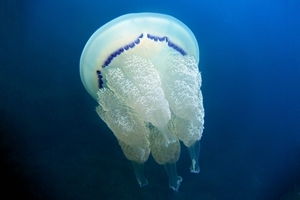Barrel jellyfish
 You may see jellyfish washed up on the seashore at various times of year, but we’re coming into the season where you might encounter one of the biggest: the barrel jellyfish (Rhizostoma pulmo).
You may see jellyfish washed up on the seashore at various times of year, but we’re coming into the season where you might encounter one of the biggest: the barrel jellyfish (Rhizostoma pulmo).
We have six species of jellyfish around the coasts of Britain, and two visiting jellyfish-like ‘hydrozoans’: the Portuguese man o’ war and the by-the-wind sailor. Jellyfish are ‘cnidarians’ – a classification that includes anemones, corals, and sea pens, whips and fans. They are relatively simple creatures without circulatory systems, brains, heart or lungs. They respond to the environment around them using nerves, and they more or less drift where the tides take them, which is why they are often unceremoniously dumped onshore by strong winds, swells and currents.
The barrel jellyfish is most often seen off the coast of the southwestern British Isles, but as you may see in the news from time to time, marine animals have a habit of turning up anywhere! Barrel jellyfish vary in abundance from year to year and are thought to live in the deep sea during winter, moving inland in spring to breed in shallower water, which is why swarms are more common between May and June.
Despite being 95% water, the barrel jellyfish appears fairly solid and opaque in comparison to other jellyfish, making it look rather like the mushroom cloud of an atomic bomb. The domed ‘cap’ can measure up to a metre across, earning it the alternative name of dustbin-lid jellyfish, and the biggest specimens can exceed 1.5m in length and 35kg in weight.
Usually we think of jellyfish as having threadlike stinging tentacles, but the barrel jellyfish actually has eight thick ‘arms’ on which tiny tentacles are arranged, giving it a bulky, frilly appearance. These tiny tentacles have mouthparts that contain a sting, in order to stun and consume plankton and small fish. The sting is mild and therefore not dangerous to humans.
The texture of the tentacles on the arms resembles cabbage and cauliflower, perhaps explaining why it is called a ‘cabbage bleb’ in some parts of the world – if you’re looking for a new creative insult, that seems like a good one. But who knows, maybe it’s because it tastes bland? In Southeast Asia, people have caught and eaten jellyfish from the Rhizostomae order for over 1,700 years and have even farmed them. The flesh is dressed in strong flavours like sesame oil and soy and served up as ribbons in salads, in sushi, in noodles and even ice cream. They say in future we may become more reliant on invertebrates for the global food supply, but I don’t think ice cream made from these creatures will ever be an agreeable replacement for Mr Whippy.
As for non-human predators of barrel jellyfish, at the top of the list are oceanic sunfish and turtles, neither of which occur commonly in British waters but are occasionally attracted here if conditions are favourable and numbers of prey are good. Barrel jellyfish are a favourite food of the largest sea turtle in the world, the leatherback turtle. This huge reptile is now endangered, at least in part due to consumption of plastic bags mistaken for jellyfish.
Now, for the fascinating life cycle. I would discourage you from Googling this further unless you are a marine microbiologist because you will be confronted with sentences comprising 75% gobbledegook (“heterotrichous microbasic euryteles are observed in polyps, ephyrae, and medusae,” says one paper by Holst et al. in the journal Marine Biology). Despite being simple beings, barrel jellyfish are advanced enough to have developed sexual reproduction, so there are both male and female jellyfish of most species, though they can clone themselves as well. When an egg is released it may be free-living and go on to become an adult ‘medusa’ jellyfish, or it might develop into a ‘polyp’, which anchors on the seabed and then asexually divides into clones. A fully grown jellyfish medusa can spawn daily, and the release of spawn is often synchronised to a specific time of day, which I think you will agree is rather clever for something without brains!
Lastly, when jellyfish group together, the collective is referred to as a ‘smack of jellyfish’, which sounds rather thuggish, or, more affectionately, a ‘fluther of jellyfish’ – which I think is a good term for these rudimentary creatures drifting around our coasts with their frilly arms.
Jess Brooks
Advisory
Photo credit: Tato Grasso